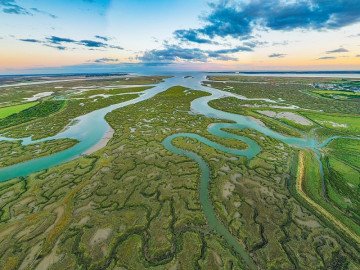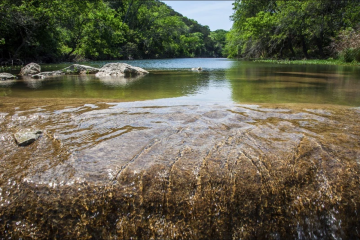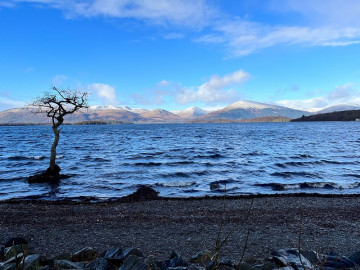World Water Week, an annual event that focuses on global water issues, just wrapped up in Stockholm, Sweden. Two Antea Group water stewardship experts, Erica Pann, and Natalya Holm, share their key takeaways from this exciting event below.
It has been a week since World Water Week in Stockholm, and we have finally had some time to digest all the amazing insights from our time in Sweden. World Water Week was an incredible opportunity for dialogue, cooperation, and building partnerships. Whether water found us, or we found water, everyone in attendance had a passion for water stewardship and had felt, to some degree, the impacts of the global water crisis. With the added weight of climate change as a threat multiplier, we find ourselves with much that urgently needs to be accomplished in the water space. The best available solutions require attention and patience for long-term success. Fortunately, our biggest takeaway message was that while water risks are interconnected and interdependent, so are the solutions.
Value of Water
The theme for this year’s World Water Week was ‘Seeing the Unseen: The Value of Water.’ Many sessions focused on just this - the importance and dire need to value our limited water resources with more accuracy. Throughout the week, experts provided updates on the leading tools and approaches to support water valuation through better data collection and visualization, increased transparency, and of course, an emphasis on collaboration.
Thought leaders in this space support the creation of an internal price on water for the private sector to better and more appropriately account for the nuanced costs of water, such as social costs. Just like with carbon, this internal price would more effectively assign a monetary value on water use, which businesses can then factor into investment decisions and long-term business operations. While many of these options may seem untenable to our corporate clients, the hope is that considering the value of water more holistically would encourage us all to reduce inefficiencies and to be better stewards of our precious resources.
Co-Benefits
As consultants, our interest is naturally geared towards mobilizing the private sector towards action. A promising theme was the concept of co-benefits – when a company takes holistic action on water, it leads to positive effects on related issues. For example, we heard about positive outcomes in the food-water, climate-water, and social-water nexus, where water projects (especially nature-based solutions) had a myriad of related positive outcomes, including improved food security through improved agricultural yield, improved public health, and increased ecological resiliency and biodiversity. These co-benefits can also translate to ROI for private companies and their investors:
- investment in WASH has been shown to lead to a reduction in absenteeism and workplace incidents;
- investment in water stewardship leads to savings through improved water quality, increased yield, and job creation;
- investment in water efficiency decreases carbon emissions and leads to increased capacity and growth.
Nature-Based Solutions
Nature-based Solutions (NbS) have come up time and again as the preferred approach to tackle socio-environmental challenges, especially surrounding water, largely because of their success in maximizing the co-benefits. We are slowly moving towards a blend of NbS and traditional/grey infrastructure solutions to water-related issues, but there remains a huge potential to implement NbS in order to maximize benefits and minimize costs. It is important to note, however, that NbS can be slower to implement, so they require both patience and building a partnership with the local stakeholders in order to ensure long-term success.
Valuing of Wastewater
Much like NbS, wastewater reuse and recycling (circularity) is a relatively well-established solution that is just waiting for us to better employ and utilize. While the sessions on valuing wastewater during the week focused primarily on domestic wastewater reuse, the circularity landscape is noticeably shifting to corporate responsibility in maximizing these opportunities. It was widely agreed that we indeed have several feasible solutions to our water crisis, we just need to face the inevitability that we will need to use them - i.e., thinking circularly.
Scaling Up
In order to accelerate the impacts of effective water projects and solutions, we are met with the challenge of scaling these solutions to apply to a wider variety of contexts and situations. This concept is far from new, and has been a leading concern in water stewardship efforts for some time. Because water is a hyper-local issue, there are also no one-size-fits-all solutions – every watershed is unique, and water stewardship initiatives can be met with a variety of roadblocks, whether they may be cultural, financial, or environmental. Our call to action is to continue gathering relevant data, sharing it with local and global stakeholders by building strong public and private partnerships, and coalescing lessons learned for the larger water community.
Partnership and Looking Forward
If we are to have any hope of driving a positive impact on water issues, partnerships and cross-sectoral collaboration are the necessary mechanisms to achieve it. Events like World Water Week are an important stage to begin developing relationships and begin building trust among the various players in the water space, and we must continue the momentum by going from one conversation to dialogue, to action. To quote a brilliant water practitioner, Dr. Sanjeev Chada with the Pacific Institute, “We need to work much faster, and much better together”.
Please reach out to Natalya Holm and Erica Pann with your thoughts or questions, let’s keep this conversation going!
Want more news and insights like this?
Sign up for our monthly e-newsletter, The New Leaf. Our goal is to keep you updated, educated, and even a bit entertained as it relates to all things EHS and sustainability.
Have any questions?
Contact us to discuss your environment, health, safety, and sustainability needs today.








